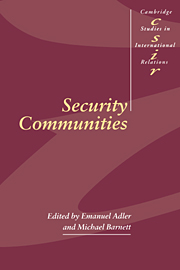Book contents
- Frontmatter
- Contents
- Notes on contributors
- Acknowledgements
- Part I Introduction and theoretical overview
- Part II Studies in security communities
- 3 Insecurity, security, and asecurity in the West European non-war community
- 4 Seeds of peaceful change: the OSCE's security community-building model
- 5 Caravans in opposite directions: society, state and the development of a community in the Gulf Cooperation Council
- 6 Collective identity and conflict management in Southeast Asia
- 7 An emerging security community in South America?
- 8 Australia and the search for a security community in the 1990s
- 9 The United States and Mexico: a pluralistic security community?
- 10 No fences make good neighbors: the development of the US-Canadian security community, 1871–1940
- 11 A neo-Kantian perspective: democracy, interdependence and international organizations in building security communities
- Part III Conclusions
- Index
- CAMBRIDGE STUDIES IN INTERNATIONAL RELATIONS
11 - A neo-Kantian perspective: democracy, interdependence and international organizations in building security communities
Published online by Cambridge University Press: 30 October 2009
- Frontmatter
- Contents
- Notes on contributors
- Acknowledgements
- Part I Introduction and theoretical overview
- Part II Studies in security communities
- 3 Insecurity, security, and asecurity in the West European non-war community
- 4 Seeds of peaceful change: the OSCE's security community-building model
- 5 Caravans in opposite directions: society, state and the development of a community in the Gulf Cooperation Council
- 6 Collective identity and conflict management in Southeast Asia
- 7 An emerging security community in South America?
- 8 Australia and the search for a security community in the 1990s
- 9 The United States and Mexico: a pluralistic security community?
- 10 No fences make good neighbors: the development of the US-Canadian security community, 1871–1940
- 11 A neo-Kantian perspective: democracy, interdependence and international organizations in building security communities
- Part III Conclusions
- Index
- CAMBRIDGE STUDIES IN INTERNATIONAL RELATIONS
Summary
In this chapter I explore elements of a partial but arguably nascent global security community. To think about such a global scope requires treating the concept of security community somewhat loosely, and surely it applies unevenly, to some regions more strongly than to others. At one end of the spectrum, some “hot spots” manifest no security community whatsoever; other parts of the global system have plausibly reached the stage of ascendant (South America) and even mature (Europe) security communities. Overall, true interstate conflicts have become rare with the end of the Cold War, just as intrastate conflicts have multiplied. So what we must do here is to consider elements - partial and potential as well as actual - of a global security community. In doing so we take the hard case, focusing on global processes and institutions and thereby push the envelope of this discussion on security communities. What seems to be transpiring, at the very least, is a blurring and extension of the boundaries of regional security communities, as they exist or as they are emerging.
By focusing on the global parts, particularly the United Nations, I do not imply that everything about these organizations works as intended. Rather, I am trying to capture the essential vision of many of the founders of the UN, previous commentators, and recent contributions
to the discourse on reforming the UN.
A Kantian framework
As a way of introducing some of these elements in a Kantian framework, begin with a puzzle about the end of the Cold War.
- Type
- Chapter
- Information
- Security Communities , pp. 368 - 394Publisher: Cambridge University PressPrint publication year: 1998
- 19
- Cited by



